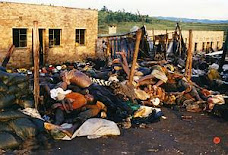FREETOWN, 8 December 2014 (IRIN) - In the week ending 30 November, Sierra Leone reported 537 confirmed Ebola cases, 152 more than the previous week and over four times the combined number of cases in Guinea and Liberia during the same period, according to World Health Organization's (WHO) latest
updates.
For more than a month, the outbreak has been slowing in Liberia, which reported 43 cases from 24-28 November. In Guinea, where the virus was first reported in March, there has been a slight increase in cases since October. Seventy-seven cases were reported in the last week of November, says WHO.
Health authorities in Sierra Leone say the continued denial of the existence of Ebola and unsafe burials are driving up infections. Seventy percent of infections are due to unsafe burials of Ebola victims, Brima Kargbo, chief medical officer at the Ministry of Health and Sanitation, told reporters on 3 December.
"The issue of denial is still [widespread] in our communities despite the fact that there is increased awareness and sensitization. People continue to hide the sick; people continue to wash bodies," Kargbo said.
"What we have done is continue to engage the community leaders - for them to fully understand the risk factors of Ebola and for them to see the need to be involved in the fight [against Ebola] by reporting early when their loved ones are sick; at the same time for people not to bury without the support of the medical teams."
"A difficult human problem" In September, the Sierra Leonean government ordered a three-day nationwide lockdown in a bid to contain the spread of Ebola. It said the curfew was successful. However, of the three West African countries battling Ebola, Sierra Leone currently has the highest transmission rates.
"It's really hard to change what we do, as cultures, at the moment of death. Imagine a mother being told not to cuddle her dead child? Who of us could?"
While infections have largely been brought down in the country's eastern region where Ebola first emerged earlier this year, the virus is spreading aggressively in the Western Area region that includes the capital Freetown. Of the 93 confirmed
cases reported on 3 December, 75 were from Western Area.
Lack of space in Ebola isolation centres in Western Area, infections during transportation and in isolation centres, as well as population movements, are some of the
other factors behind the intensive spread of the virus.
"It's really hard to change what we do, as cultures, at the moment of death. Imagine a mother being told not to cuddle her dead child? Who of us could? Behaviour change sounds very sterile, but when you break it down and think about what that means, it becomes a very [difficult] human problem," Winnie Romeril, WHO spokesperson in Sierra Leone, told IRIN.
Slow response The emergency medical response has also been criticized as inefficient. Calls to a toll-free line for the ambulance service or burial teams to collect bodies are rarely responded to in a timely manner. Kargbo said the burial and surveillance teams have now been doubled to 160, and an assessment was under way to determine whether the response is improving.
"The government should have taken drastic action to quarantine towns and villages where Ebola first erupted. [It] should not have allowed Ebola to spread in every district of the country," said Mariama Kargbo (no relation to Brima) who lives in the capital.
"I can't go visit my relatives in other parts of the country because it's very stressful and expensive to travel now. The government needs to do more. Every day you hear ambulances with siren passing. When you look, it's an Ebola ambulance. If I had the chance I would leave the country. It's very sad."
Elhadj As Sy, secretary-general of the International Federation of Red Cross and Red Crescent Societies (IFRC), told a news conference recently that due to the stigma associated with Ebola infection "there are many patients who go underground and there are still many people falling sick and their families are not opening up for them to be collected," he said.
Behaviour change But Sy stressed that the majority of Ebola patients were seeking treatment and many people were observing health and safety measures and shunning risky practices. Sidi Yahya Tunis, communication officer at Sierra Leone's National Ebola Response Centre, said that while dangerous beliefs and practices among certain communities still remained "the key obstacle that we see in this fight", increased collaboration with communities was being built to rein in Ebola.
Ebola survivor Mohamed Conteh in the eastern town of Kenema lauded public information campaigns by the government and aid organizations. "For me if it was not for the way the government has been responding to educate people about the virus and improving the treatment centres, I may have lost my life or more people would have died," he told IRIN.
However, the target set by the UN Mission for Ebola Emergency Response to isolate and treat 70 percent of patients and safely bury 70 percent of Ebola victims by 1 December in Guinea, Liberia and Sierra Leone was only partially achieved: Guinea and Liberia exceeded the target to isolate and treat patients but Sierra Leone fell short.
The ultimate goal, by 1 January 2015, is to be able to isolate all Ebola cases and safely bury all those who succumb to the virus.
ob/js/cb
Access report online











No comments:
Post a Comment
Note: only a member of this blog may post a comment.